 The Cards:
I put the new Visiontek GeForce4 MX 440
and 420 cards through some
comparison testing against GeForce2 Pro and GeForce3 Ti 200 cards to see
if the new cards performed better or worse. The models I used for
comparisons were the Asus V7700 Deluxe GeForce2 Pro 32MB DDR card and the
Visiontek GeForce3 Ti 200 64MB DDR cards.
The Cards:
I put the new Visiontek GeForce4 MX 440
and 420 cards through some
comparison testing against GeForce2 Pro and GeForce3 Ti 200 cards to see
if the new cards performed better or worse. The models I used for
comparisons were the Asus V7700 Deluxe GeForce2 Pro 32MB DDR card and the
Visiontek GeForce3 Ti 200 64MB DDR cards.
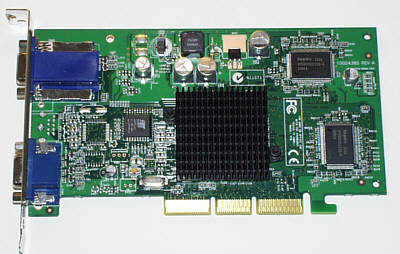
This is the GeForce4 MX440 card with 64MB of DDR
DRAM. Quite basic, and nothing really fancy, unless you consider
Twin-View dual-monitor support fancy. And in a way, it is. The
dual-monitor support on the MX440 is quite impressive.

The GeForce4 MX420 is even more basic. This one
almost looks like a network card it's so small. But it still has
room for an S-video out connector so you can play games on a large TV.
Finally, I also compared the performance of the
new GeForce4 MX cards to the built-in GeForce2 MX video that comes with
nForce motherboards.
Introduction:
So is the GeForce 4 MX anything to get excited about? In fact, the MX 440
comes equipped with DDR DRAM, and it puts in a very commendable performance
as you will see. The MX 420 is a real budget card, yet it still manages some
quite decent scores.
Both cards have two output connectors. The MX420 has
an extra S-video out for TV gaming, while the MX440 has dual-monitor support
with excellent driver utilities for controlling both monitors in
spanning and non-spanning modes.
Rather than do an exhaustive test of these cards
with Quake III, Serious Sam, Unreal, and the rest of the usual lineup, I
concentrated on 3D Mark 2000 and 2001 to test Direct X 7 and 8 performance
respectively. I only tested two resolutions and color depths at the
two ends of the playable spectrum with these lower-end cards (640x480x16
and 1024x768x32).
System: I tested the video cards on
what I consider a fairly basic new system with NVidia's new nForce
chipset, including integrated sound and video. The motherboard was Asus' new
A7N266 with DDR memory support. The system contained 256MB of Crucial
PC2100 DDR DRAM and a 1.466 GHz (XP 1700+) Athlon CPU running at 11 x 133MHz
(CPU and memory front side bus at 133MHz). The system had Windows 98SE and Direct X
8.1 installed, and the latest nForce drivers from NVidia's web site.
Video Drivers:
For most testing I used the latest 27.30 NVidia
drivers that come with GeForce4 MX cards. For testing the old GeForce2
card, I used the 23.11 WHQL drivers available from NVidia's web site. It
is interesting that NVidia is only offering the 23.11 drivers for
download, rather than putting the new 27.11 drivers up as well.
3D Mark 2000 (Direct X 7)
I ran 3D Mark 2000 version 1.1 to test what kind of performance you can expect in
various Direct X 7 3D games. The results are shown in the next graph.
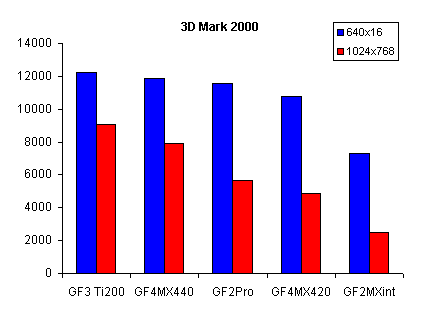
The blue bars are for 640x480 at
16-bit, while the red bars are for 1024x768 at 32-bit color. The red bars
really represent what resolution and color depth you would prefer to run
your games at if possible. Running games at 800x600 with 32-bit color is
perfectly good for 17 inch monitors, but if you have a 19 inch monitor,
1024x768 is the preferred setting.
From the graph above it's clear
that the MX440 is darned close to the Ti200. The price difference is
negligible as well. The surprises for me are the excellent showing that
the MX420 puts in (GF2 Pro equivalent), and the terrible showing for the
integrated nForce video (Less than 1/3 the score for the MX440 at
1024x768x32).
3D-Mark 2001 (Direct X 8)
Now we get to the benchmark that was designed
for the GeForce 3 and 4 cards, the new 3D Mark 2001se (second edition).
This benchmark makes $400 video cards cry for mercy. But take a look at
Direct X 8 performance on these low-end cards.
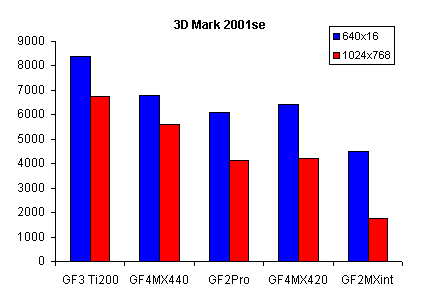
The Ti200 really does well here,
with good tight scores at both settings. The MX400 does exceptionally well
too, beating the GF2 Pro nicely. Notice also that the MX420 does a very
good job with Direct X 8 performance at a very affordable price. It meets
or beats a GeForce2 Pro, and puts the onboard video to shame.
What I notice here the most is that the MX440 does
not do as well with DX8 as compared to the GF3 Ti200. These two cards
performed very similarly with DX7 (3D Mark 2000). But with Direct X 8 (3D
Mark 2001se), there is now a significant advantage for the GF3 Ti200.
Take home messages? If you have an
original GeForce2 MX card, the GeForce4 MX420 is a significant upgrade. If
you have a GeForce2 Pro, the GeForce3 Ti200 is a significant upgrade, but
the GeForce4 MX440 is not.
Overclocking GeForce Cards
I used Powerstrip 3.12 (Entech)
to overclock the core and memory on the GeForce cards. If you haven't tried
Powerstrip, I highly recommend it. You can get it here:
http://www.entechtaiwan.com/ps.htm
The default graphics core and memory settings on the
5 cards I tested are:
Standard speeds:
GeForce2 Pro:
200MHz/333MHz
(core - memory)
GeForce3 Ti 200: 175MHz/400MHz
GeForce4 MX 420: 125MHz/166MHz (SDRAM)
GeForce4 MX 440: 135MHz/200MHz (DDR)
GeForce2 MX (int): 50MHz/50MHz?
Overclocked settings:
GF2 Pro Overclocked: 210MHz/350MHz
GF3 Ti 200 Overclocked: 185MHz/440MHz
GF4 MX420 Overclocked: 135MHz/190MHz
GF4 MX440 Overclocked: 145MHz/230MHz
GF2 MXint. Overclocked: not overclockable
The on-board GeForce2 MX
video (labeled GF2MXint in graphs) on the nForce motherboard would not overclock at all. I am not sure
exactly how the nForce board uses system memory for AGP functions, but the
default readings with Powerstrip read out as 50MHz core, 50MHz memory. The
memory slider would not move (because it's system memory), and the core
slider always caused the system to crash, whenever I tried to change the
setting. I set the nForce motherboard BIOS to allow video overclocking, but this had
no effect on the lack of overclockability. I think it's safe to say that the onboard video
on nForce motherboards is not
particularly tweakable.
The graphs below show the benchmarks with the
overclocked settings.
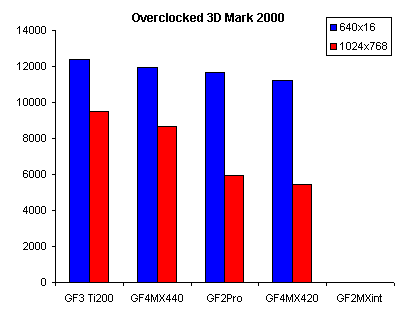
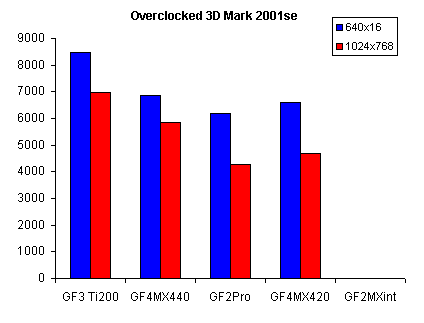
Overclocking these cards gave
marginal increases in performance (for example, 9% for the GeForce4 MX 440
at 1024x768x32).
nForce Chipset
NVidia's move into the chipset
market is a logical extension of their move to to console market, where
graphics and memory are integrated. But in the case of the nForce
integrated video on the current chipset, I've got to wonder what they were
thinking. Maybe servers? The onboard video on nForce motherboards is not anywhere near up
to snuff for newer 3D games, and is barely good enough to run older games
at acceptable resolutions and frame rates. But other than the built-in
video, the nForce chipset is impressive. The memory support is very good,
and the built-in audio is far superior to the Yamaha chips integrated on
many motherboards. What NVidia needs to do is remove the on-board video
altogether, and add 10/100 Ethernet support. The newer nForce 415-D
chipset without the built-in video is a great idea, now let's get with the
integrated fast Ethernet guys!
Conclusions
If you want raw power and speed in
your graphics system, you'll want to save your money for something gutsier
than MX cards. But if you have an old GeForce2 MX card, and you're on a budget,
the MX 440 is one heck of a nice budget card. Keep in mind that the
GeForce3 Ti 200 beats the MX 440 in every benchmark, and only costs about
$20 to $30 more. In my opinion, the extra $30 is worth the money. Also
keep in mind that the GeForce 4 Ti 4200 should be available soon, and it
will beat the GeForce3 Ti 200, for just about the same price. The MX420 is
a damn good video card at the bottom end. For about $100, you get GeForce
2 Pro performance... with good 'ol SDRAM!
Final words. If you have a
really old video card and it's giving you trouble, but you are also flat
broke, the MX420 will beat the pants off of a Voodoo3 or TNT2
card. If you have a little more cash on hand, the MX440 is an even better choice
to replace an old video card. But for just a few dollars more, you can get
a full-fledged GF3 Ti200, which has twice the number of pipelines, and
faster memory.
But one thing is clear folks, the low-end of computer video isn't
so low anymore, thanks to NVidia.
Pros:
- MX 440 is a good choice for budget
gamers
- MX 420 excellent for it's price range
- Complete Direct X 8 support
- MX 440 has great dual monitor support
- MX 420 is dirt cheap
- Programmable special effects
- Overclockable
|
Cons:
- MX 440 is almost as expensive as GF3 Ti
200
- GeForce3 Ti200 is fairly inexpensive, and
beats both GeForce4 MX cards in all benchmarks
- Not much in the way of cooling on these
cards
- Built-in video on nForce motherboards
is pitiful
GeForce4 MX 440:
Price:
Approximately $165 US
Rating, :
4.5 out of 5 smiley faces (90%).
:) :) :) :) +
GeForce4 MX 420:
Price:
Approximately $120 US
Rating, :
4.3 out of 5 smiley faces (86%).
:) :) :) :) +
Availability for
both cards:
Good
|
© Copyright, March 10th, 2002
|